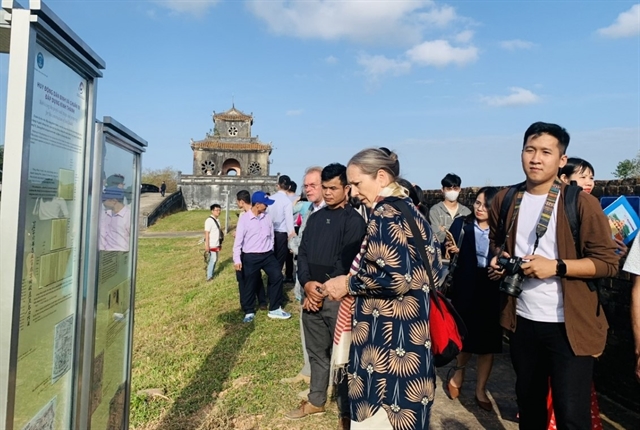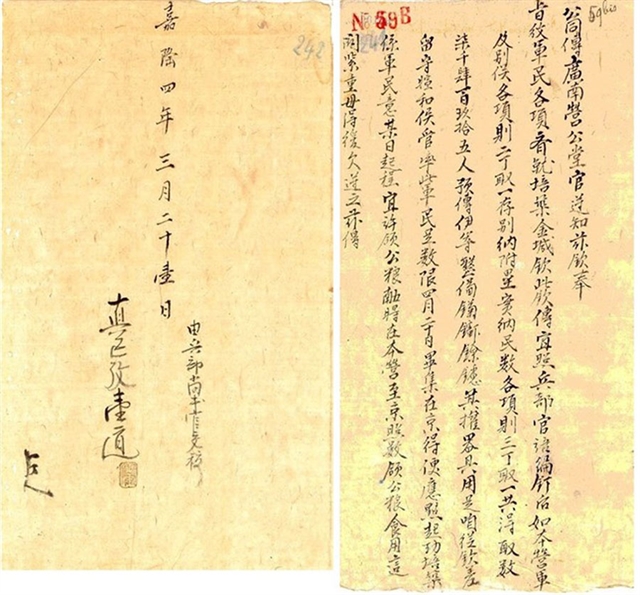 Life & Style
Life & Style

 |
| Visitors view the royal documents at the opening ceremony on Wednesday. Photo courtesy of Huế Monuments Conservation Centre |
HÀ NỘI — Nearly 100 royal documents on Huế Citadel building are on display for the first time at Ngọ Môn Square in the Imperial City of Huế.
The display, Kinh Thành Huế - Dấu Xưa Còn Lại (Huế Capital City - Old Traces Remain), is co-held by National Archive Centre No1 and Huế Monuments Conservation Centre, helping local people and tourists have more information to better understand the ancient citadel.
"We want to popularise the value of the royal documents," said Trần Thị Mai Hương, the centre's director, at the opening ceremony on Wednesday.
"The royal documents tell the story of the citadel building in the past. Through the exhibition visitors have a chance to get to know the culture and history of this ancient land."
Huế Citadel was the capital of the Nguyễn Dynasty for 140 years. Although the Nguyễn dynasty has passed, Huế Citadel retains its remarkable ancient architecture and is also the most popular tourist destination attracting many visitors.
As Huế was the capital of the country from the 17th to the 20th centuries, its citadel had been well constructed during that time. The Huế Citadel includes three layers of walls.
Under the Nguyễn Dynasty, Huế Citadel was a centre of political power and policy application, according to Huế centre's director Hoàng Việt Trung.
"Throughout its history, Huế Citadel witnessed significant events, including royal ceremonies, political meetings, and even battles," Trung said.
"This area witnessed the glorious time of Nguyễn Dynasty, and ups and downs of the last dynasty," said Trung. "Huế Citadel closed the feudal period when King Bảo Đại abdicated in 1945. Tragically, the citadel suffered extensive damages from war and the passage of time.
"The erased and the existing works remain in names in Nguyễn royal documents."
 |
| Nguyễn royal documents on display for the first time. — Photo courtesy National Archives No1 |
The display includes two parts. The first part introduces history and development of the citadel from Phú Xuân - Thuận Hóa and Huế, and the second part features traces of Nguyễn dynasty.
In 1802, right after reunifying the country and ascending to the throne, King Gia Long, the first king of the Nguyễn Dynasty, decided to choose Phú Xuân - Thuận Hóa to build the Huế Citadel.
At that time, people only travelled by elephants and horses, the king thought that the capital must be located between the two ends of the country to facilitate the exchange of information. After that, people planned the citadel and construction began in 1805. King Gia Long and ministers of the Nguyễn Dynasty took care of the entire field survey process.
"The exhibition introduces a systematic set of documents including Nguyễn royal documents with photos from the 19th century and the old maps," said Huế-based researcher Nguyễn Xuân Hoa.
"It is not only Huế Citadel building under King Gia Long reign, but the royal documents also introduce old capitals of other Nguyễn dynasties. They are very reliable."
As well as being the stronghold of the last independent Vietnamese dynasty, the citadel played an important role in the history of Việt Nam. It was listed as a UNESCO World Heritage site in 1993 and the remaining buildings are being restored and preserved.
The display is expected to be a permanent feature at Ngọ Môn Square. — VNS




